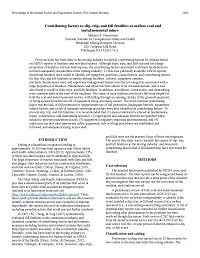Mining Publication: Contributing Factors to Slip, Trip, and Fall Fatalities at Surface Coal and Metal/Nonmetal Mines
Original creation date: September 2016
Authors: MF Nasarwanji
NIOSHTIC2 Number: 20049235
Proceedings of the Human Factors and Ergonomics Society 60th Annual Meeting, September 19-23, 2016, Washington, DC. Santa Monica, CA: Human Factors and Ergonomics Society, 2016 Sep; 60:1666-1670
Previous work has been done in the mining industry to identify contributing factors for injuries based on MSHA reports of fatalities and non-fatal injuries. Although slips, trips, and falls account for a large proportion of fatalities and non-fatal injuries, the contributing factors associated with these incidents have not been adequately documented in the mining industry. To this end, publically available MSHA reports describing fatalities were coded to identify job categories, activities, causal factors, and contributing factors for slip, trip, and fall fatalities at surface mining facilities. Laborer, equipment operator, mechanic/maintenance man, and supervisor/management/trainer were the job categories associated with a large proportion of fatalities. Maintenance and repair has been shown to be a hazardous task, and it was also found to result in slips, trips, and falls fatalities. In addition, installation, construction, and dismantling were common tasks at the time of the incidents. The cause of most fatalities involved a fall from height for both the coal and metal/nonmetal sectors, with falling through an opening, failure of the ground/equipment, or being ejected from/thrown off of equipment being secondary causes. The most common contributing factor was the lack of fall protection or inappropriate use of fall protection. Inadequate barriers, equipment-related factors, and a lack of adequate operating procedure were also identified as contributing factors. To prevent slip, trip, and fall fatalities, it is recommended that (1) special attention be placed on maintenance, repair, construction, and dismantling activities, (2) appropriate and adequate barriers are installed when needed to prevent inadvertent access, (3) equipment is regularly inspected and maintained, and (4) employees are provided appropriate safety equipment, safe working procedures are established and followed, and adequate training is provided.

NIOSHTIC2 Number: 20049235
Proceedings of the Human Factors and Ergonomics Society 60th Annual Meeting, September 19-23, 2016, Washington, DC. Santa Monica, CA: Human Factors and Ergonomics Society, 2016 Sep; 60:1666-1670
- Assessing and Monitoring Open Pit Mine Highwalls
- Blasting Injuries in Surface Mining with Emphasis on Flyrock and Blast Area Security
- Burden Associated with Nonfatal Slip and Fall Injuries in the Surface Stone, Sand, and Gravel Mining Industry
- Don't Slip Up!
- Falls Can Kill!
- Infographic: Falls Can Kill!
- Slip, Trip, and Fall Hazard Identification, Investigation, and Remediation at Surface Mining Facilities
- Slip, Trip, and Fall Prevention for Mining
- Technology News 502 - A New Training Video for Aggregate Operators: Aggregate Training for the Safety Impaired
- Toolbox Training on Flyrock Awareness